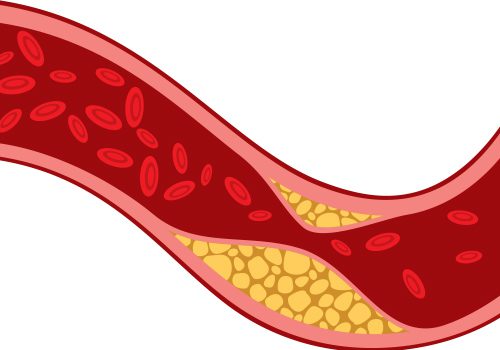[vc_row][vc_column width=”1/2″][vc_column_text]
Cholesterol
[/vc_column_text][vc_column_text]Cholesterol is a fatty substance which is essential for your body to function day to day. A certain amount of cholesterol is healthy, as it forms part of the cell walls and is also necessary to make hormones.[/vc_column_text][vc_toggle title=”What are the Different Types of Cholesterol?” style=”simple” color=”juicy_pink” custom_font_container=”tag:h4|text_align:left|color:%23dd3333″ custom_use_theme_fonts=”yes” use_custom_heading=”true”]There are two main types of cholesterol – LDL or ‘bad’ cholesterol and HDL or ‘good’ cholesterol. HDL cholesterol is beneficial to the body. However, if there is too much LDL cholesterol, it can be deposited along the walls of arteries, forming atheroma (fatty material) and causing blood vessels to become narrowed or blocked. Over time, a gradual build-up of atheroma can narrow the arteries that supply the heart with blood. This process is called atherosclerosis and may eventually cause symptoms of angina or result in a heart attack or stroke. One cause of high LDL cholesterol is a diet high in saturated fat.[/vc_toggle][vc_toggle title=”What Should My Cholesterol Levels Be?” style=”simple” color=”juicy_pink” custom_font_container=”tag:h4|text_align:left|color:%23dd3333″ custom_use_theme_fonts=”yes” use_custom_heading=”true”]
- Total cholesterol: Less than 5.0mmol/L
- LDL cholesterol: Less than 3.0mmol/L
- HDL cholesterol: More than 1mmol/L for men and more than 1.2mml/L for women
- Triglycerides: Less than 1.7mmol/L
If you have a history of heart disease, stroke or diabetes or, you are at high risk because of multiple risk factors, then your target levels for LDL cholesterol are lower:
- LDL cholesterol: 1.4-2.5mmol/L
Your cholesterol can be high for a number of reasons. High cholesterol can be genetic or due to an under-active thyroid, but in most cases, high cholesterol is due to eating too much saturated fat. Following a healthy diet and reducing saturated fat is one of the best ways to lower cholesterol.[/vc_toggle][/vc_column][vc_column width=”1/2″][vc_empty_space height=”50px”][vc_single_image image=”12319″ img_size=”medium” alignment=”center” onclick=”custom_link” img_link_target=”_blank” link=”https://croi.ie/wp-content/uploads/2020/12/Croi-Cholesterol_2018.pdf”][vc_column_text]
Click to Download our Cholesterol Booklet
[/vc_column_text][/vc_column][/vc_row][vc_row][vc_column css=”.vc_custom_1611660678390{margin-top: -20px !important;}”][vc_separator color=”juicy_pink”][vc_column_text]
Fat in Foods
A small portion of fat is needed in our diet, but fat is considered to be less healthy than other nutrients as it can raise our blood cholesterol, increase our risk to heart disease and is high in calories, which can lead to weight gain. Some fats are healthier than others. There are three main types of fat in food: saturated fat, monounsaturated fat and polyunsaturated fat. A diet high in saturated fat can increase our ‘bad’ LDL cholesterol. Replacing saturated fat with unsaturated fats is an important dietary change to reduce cholesterol levels. You should avoid saturated fats wherever possible as these can raise your blood cholesterol level.[/vc_column_text][vc_toggle title=”The Different Types of Fat” style=”simple” color=”juicy_pink” custom_font_container=”tag:h4|text_align:left|color:%23dd3333″ custom_use_theme_fonts=”yes” use_custom_heading=”true”]1. Saturated Fat
Saturated fats are found mainly in animal products such as fatty meats, processed meats, full-fat dairy products, butter, coconut oil as well as cakes, biscuits, chocolate and many processed foods.
Low-fat options have less saturated fat.
2. Monounsaturated Fat
Monounsaturated fats should be used in moderation.
Using this type of fat may help reduce cholesterol levels.
It is found in oils, such as olive oil and rapeseed oil, olive oil based spreads as well as nuts and seeds.
3. Polyunsaturated Fat
Polyunsaturated fats should be used in moderation.
Using this type of fat may help reduce cholesterol levels.
It is found in vegetable oils such as sunflower oil, nuts and seeds, polyunsaturated spreads, oily fish such as salmon, sardines, mackerel, trout and herring.
Note: All types of fat are high in calories and can lead to weight gain.[/vc_toggle][vc_toggle title=”Tips to Help Lower Cholesterol Levels” style=”simple” color=”juicy_pink” custom_font_container=”tag:h4|text_align:left|color:%23dd3333″ custom_use_theme_fonts=”yes” use_custom_heading=”true”]
- If you are overweight, aim for 1-2 pounds weight loss per week.
- Aim for 150 minutes of moderate-intensity exercise per week. This can be broken down into 30 minutes on 5 days per week, or bouts of 10 minutes accumulated over the day.
- Choose wholegrain varieties of cereal, bread, rice and pasta.
- Aim for 5 servings of fruit and vegetables per day.
- Limit red meat to maximum three times per week. Red meat includes beef, lamb, pork, veal and venison and ham. 1 portion of red meat should be no bigger than the palm of your hand. Make sure the red meat is lean and well-trimmed of visible fat.
- Replace red meat with chicken, turkey, fish, eggs or beans.
- Choose fish twice per week, with at least one day being oily. Examples of oily fish include sardines, mackerel, trout, herring or salmon. These foods are high in omega 3 oils which are good for your heart.
- Choose low-fat dairy products e.g. low-fat milk, low-fat yogurt, low-fat cheese. Remember low fat dairy has the same amount of calcium as full-fat dairy. Focus on getting your calcium from low-fat milk and yoghurts, as opposed to cheese.
- Limit cheese to less than two matchstick box size of cheese (approx. 30g) per week.
- Eat no more than 4-6 eggs per week.
- Choose healthier cooking methods – bake, boil, poach or grill food rather than fry.
- Choose heart healthy oils when cooking e.g. rapeseed oil and use sparingly.
- Choose a low-fat polyunsaturated or monounsaturated spread and spread it thinly.
- Limit foods and drinks high in fat, sugar or salt (crisps, biscuits, chocolate, soft drinks).
- If you drink alcohol, drink in moderation by keeping within the recommended weekly limits, which are 17 units for men and 11 units for women. Excessive alcohol can increase a type of cholesterol called triglycerides. Alcohol intake should be spread out over the week, aiming for at least two alcohol-free days per week. One standard unit of alcohol is:
– One-half pint of beer, stout or lager
– A small glass of wine (100mls)
– One Irish pub measure of spirits[/vc_toggle][vc_separator color=”juicy_pink”][vc_column_text]If you have any questions or concerns, contact the Croí Health Team on 091-544310 or email healthteam@croi.ie.[/vc_column_text][/vc_column][/vc_row]

